The last Italian helicopter missile cruiser
Within the frame of NATO’s ASW policy, Italy developed and launched two helicopter cruisers armed with US Terrier missiles in the early 1960s, following the success of the conversion of the Giuseppe Garibaldi: The Andrea Doria class. They were found successful but soon reports came in service about their small size and limited upgrade capabilities. A new, more modular design was seeked out already as they were just delivered to the Marina Militare.
Design development history
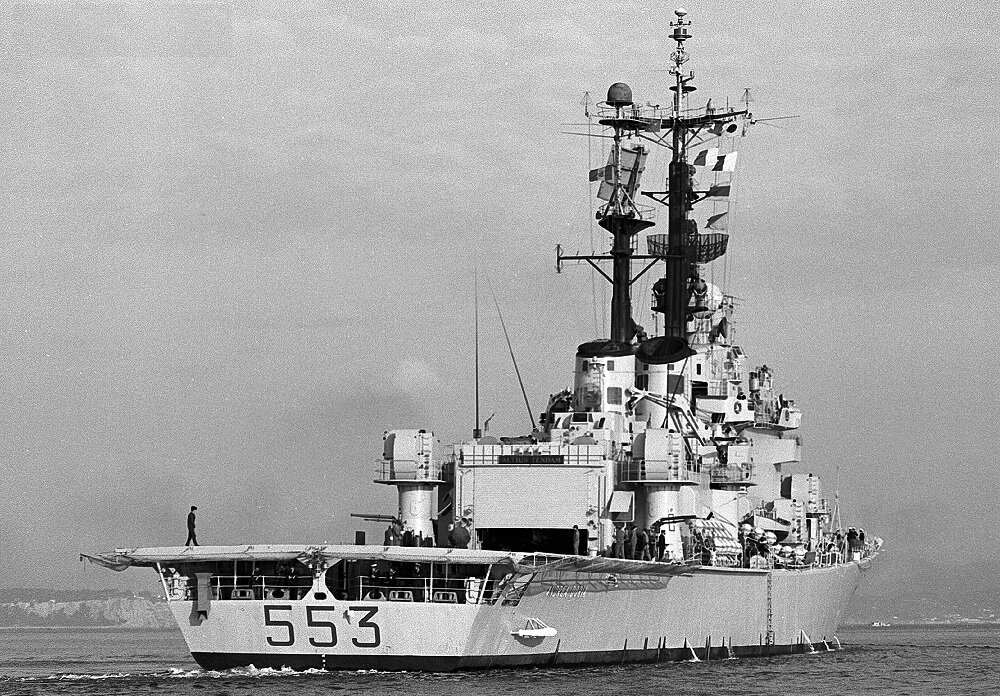
Andrea Doria’s stern
The initial design was derived directly from the Andrea Doria class, the first helicopter missile cruisers of the Italian Navy. They had a forward Mk.10 missile ramp and anti-aircraft guns around bridge, plus an aft flight to operate, housed in the associated hangar, two Sikorsky SH-3D Sea King or Agusta-Bell AB 204 heavy helicopters.
But operating only helicopters did not justified the overall cost of the ships, and that force was not efficient enough to justify the whole design. If one helicopter was in maintenance that left only one to operate, the same as any destroyer at the time. Soon the small flight deck and hangar were identified as the main issue to sold with the next design.
The design was therefore revised and expanded, the admiralty being informed that to operate at least six helicopters, a 50% displacement increase was necessary. The Marina Militare wanted to operate indeed six SH-3 Sea King helicopters, or nine light AB-204 ASW helicopters. The new design produced had had the same missile and guns arrangement but a much larger hangar and fligh deck aft, solving the whole cost-effectiveness of the program, but the Vittorio Veneto still cost much more than the first class, and after entering service in 1969, remained unique. Bugdetary constrains just prevented the construction of a siter ship at the time, which was postponed indefinitely after the 1973 crisis.
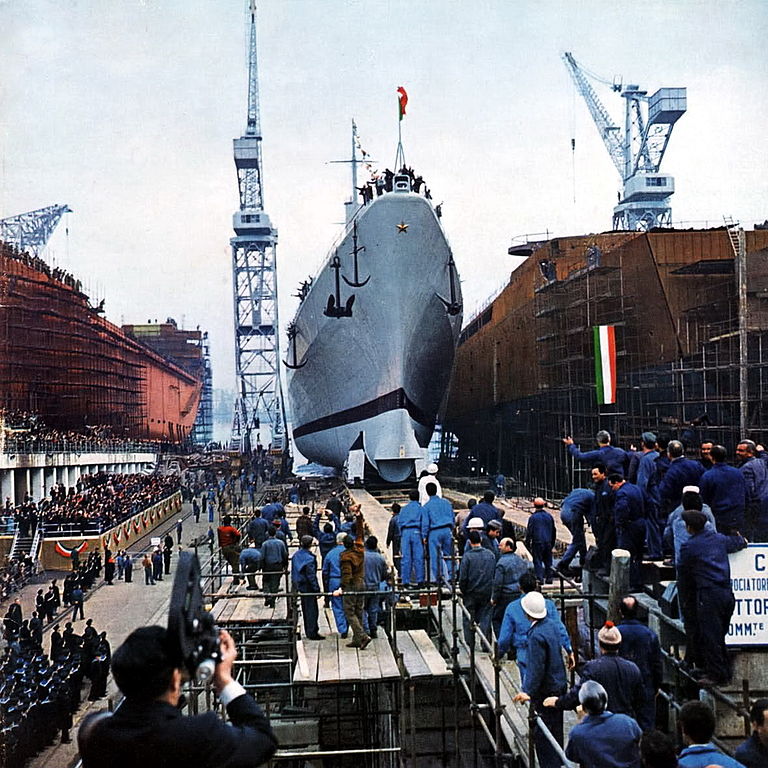
Launch of Veneto at ItalCantieri, 5 February 1967. Her motto was “Victoria nobis vita”, she had the pennant number C550 and hull number: 639 (790).
Design
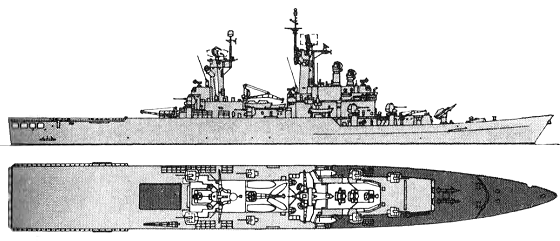
Veneto profile 1970 src navypedia
Vittorio Veneto’s overall standard displacement was 7,500 tons standard (still light compared to her side), and 8,850 tons fully loaded. Unlike the Andrea Doria class and their separate funnels, the new cruiser’s larger machinery space authorized more separaration between the turbines and thus, exhausts were split into two separated macks (combination of mast/funnels).
The second major difference was the location of helicopter facilities, with a raised rear deck aft, in order to moved the hangar below the flight deck, rather than the classic frigate/destroyer superstructure hangar arrangement of te previous ships, which made them cramped. To access the main flight deck, two renctangular elevators were managed, in the axis, to transfer wings-folded helicopters.
The much longer hull authorized better balanced and slightly lower superstrctures to be built, and more space for the electronics. The main bridge supported two forward FCS radars, one for each missile. The main Mack was installed aft of the bridge, supporting the main air search radar, with the main electronic mast at the end of the platform. The space in between superstructures housed notably service boats. The aft superstrcture started at the bas of the aft mack, which carried the remaining radars. These were dedicated FCS for the AA guns, one forward and one aft.
Powerplant
The Vittorio Veneto had a much larger machinery space, and she was propelled by two steam turbines, with an output of 73,000 shp (54,000 kW) total, for 30.5 knots (56.5 km/h; 35.1 mph). She received a set of stabilizing fins to improve stability for helicopter operations, like the previous class, a solution that proved useful.
Armament
Originally the same armament of the Andrea Doria class was planned: A Terrier SAM forward with dual role depending of the magazine used, for ASROC ASW missiles or SAMs. The magazines were completed by a third drum, for better capacity, making a total of sixty missiles of all types combined.
The Secondary armament comprised eight dual-purpose 76 mm (3 in) guns, all grouped around the superstructure and two triple 324 mm torpedo launchers, with homing Mk.46 ASW torpedoes. This was “light” for a cruiser of that size, and later additions saw this augmented considerably.
The evolution of technology cast serious doubts about the cruiser’s anti-aircraft and anti-ship defense capabilities, and the cruiser was updated and overhauled, modernized twice during her career at the Taranto Arsenal, notably in 1980-1983. At the time, Veneto had a very powerful and diversified armament suitable for many needs of the fleet and making her righfully the head of any squadron.
The flight was modernized also at the time, with the replacement of the AB 204 with the AB 212 ASW helicopter. Sea Kings in fact were seldom used due to the fact they were found too high for the cramped space in the hangar, and the few carried were stored permanently on the deck. This was not a problem in the Mediterranean though, to some extent.
Missiles:
RIM-2 Terrier/ASROC
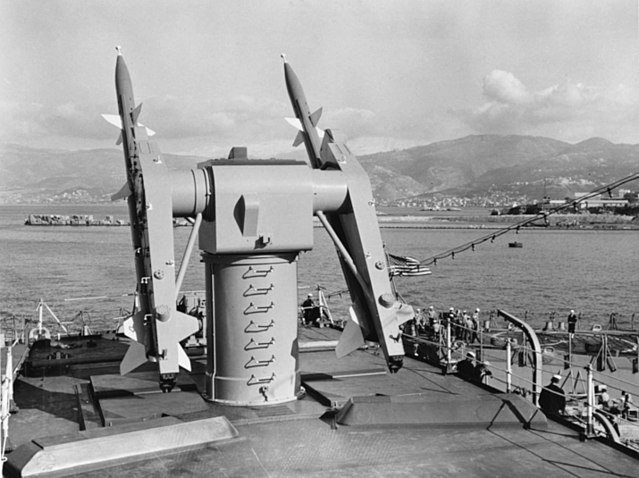
The same weapon system was installed on the converted Garibaldi. A trusted USN and NATO missile system, here used in the classic twin launcher. It used a blast-fragmentation system. The first wing-controlled and beam-riding missile capable of mach 1.8 Mach over 10 nautical miles it was by the time Veneto was completed, tail-controlled, with a semi-active homing radar, mach 3.0 over 40 nautical miles, 80,000 feet ceiling. Carried in two 20-missile barillets (40 missiles), the third reserved with 20 launcher-compatible ASROC ASW missiles. Replaced after 1985 by the more capable Standard SM-1ER and RUR-5 “ASROC”.
For the detail, a dedicated page in the armament section is in writing.
Otomat Mk.2 SSM (after modernization)
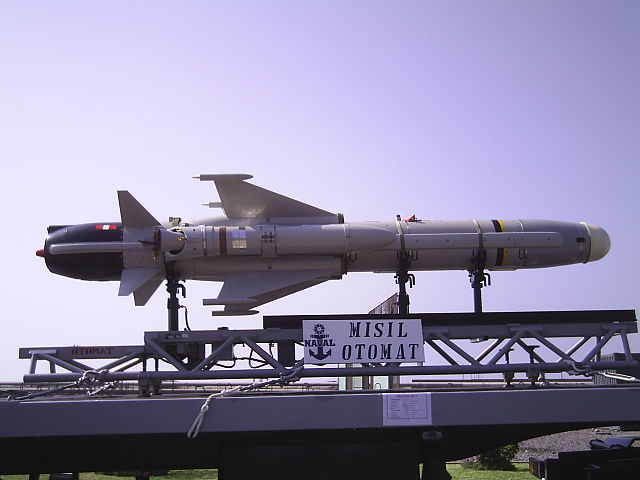
Second generation of the anti-ship missile, placed in two pairs of canister either side of the superstructure amidship. The Teseo Mk.2 SSM (1977) weighted 780 kg (1,720 lb) with booster for 6 m (19.7 ft) long,
400 mm (15.7 in) diameter and carried a 210 kg (463 lb) warhead using Impact and proximity fuse. With its turbojet engine the Mk 2 Block IV was capable of reaching 180 km (97 nmi) at 310 m/s (690 mph; 1,100 km/h; Mach 0.91), using Inertial guidance, GPS and active radar homing.
Artillery:
Eight OTO Melara 76mm/62 (1962)
 Eight AA guns was unusual for a modern cruiser, as the Veneto had Oto Melara 76/62mm MMI or 76/62 mm Compact guns, all grouped alongside the superstructure, two forward, two amidship, and two elevated on either side of the aft superstructure. They were an inheritance of the 1950s when trust to SAMs was limited, and to constitute a close quarters AA barrage for the area protection against air threats. Against modern mach-2 low-flying jets they were of limited usefulness but were dual-purpose.
Eight AA guns was unusual for a modern cruiser, as the Veneto had Oto Melara 76/62mm MMI or 76/62 mm Compact guns, all grouped alongside the superstructure, two forward, two amidship, and two elevated on either side of the aft superstructure. They were an inheritance of the 1950s when trust to SAMs was limited, and to constitute a close quarters AA barrage for the area protection against air threats. Against modern mach-2 low-flying jets they were of limited usefulness but were dual-purpose.
In brief: 12 tonnes (26,000 lb), 62 caliber or 4,724.4 mm (186.00 in), one operator inside the turret,
76×636mmR shell caliber 76.2 mm (3.00 in), automatic loading, Elevation -15°/+85° at 40°/sec., Traverse 360° at 70°/sec, 55/60 rpm, Muzzle velocity 900 m/s (3,000 ft/s) and with the HE round at 45° 16,000 m (17,000 yd) range. Connected to a chain and ammo storage below the barbette. This weapon system was standard in the cold war Marina Militare, and cincluded destroyers, frigates, corvettes and OPVs.
Three OTO Melara 40mm/70 rapido (after modernization)
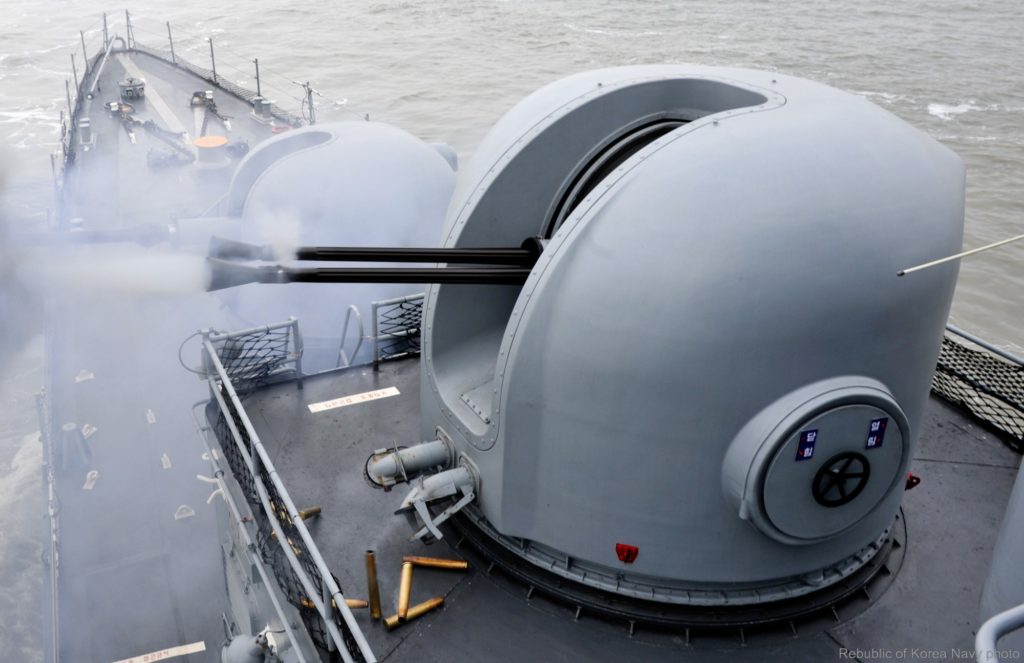
A more modern and smaller weapon system, two twin turrets installed, either side of the hangar lift aft in the 1980s refit and another forward, centerline on an elevated position with its FCS radar behind. The close-in weapon system (CIWS) Dardo was manufactured by Breda and Oto Melara, composed of two Bofors 40 mm firing HE shells, directed with a fire-control radar RTN-10X and the fire-control system RTN-20X/Dardo. Although much slower than 600/900 round per minute it is reputed able to destroy incoming missiles in flight by shrapnels. Its competitors US, Dutch or Russian are 20-30 mm indeed with barelled guns (Gatling system).
ASW TTs:
324 mm triple torpedo tubes standard US Pattern, firing Mark 48 homing acoustic torpedoes for ASW warfare. They were placed deck aft, close to the aft main 76 mm guns and still there after the modernization.
Onboard Aviation
Vittorio Veneto could operate up to nine light helicopters, of the types Agusta-Bell AB-204 or later AB-212 or six heavy helicopters of the type AB-61 (Sea King under licence) which could be housed in the hangar beneath the long rear deck.
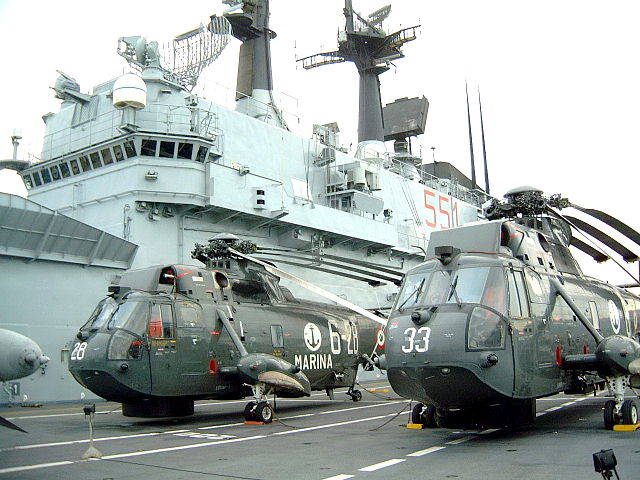
Agusta-Bell 61 Sea King
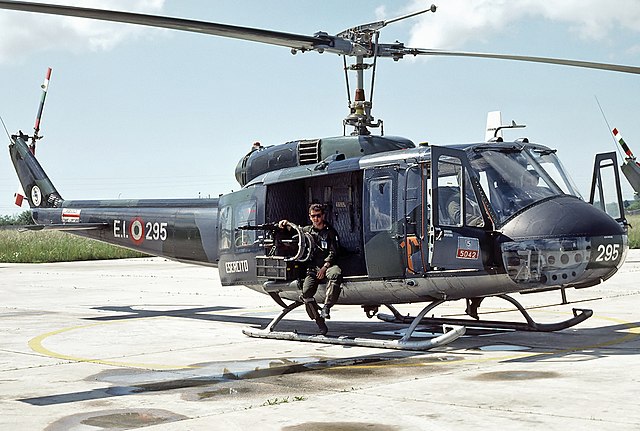
Agusta-Bell 205
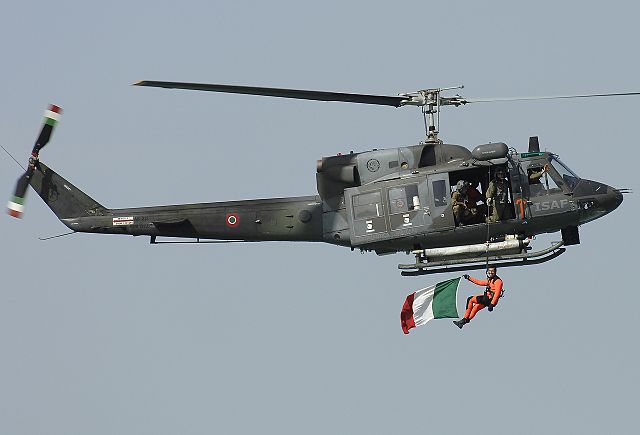
Agusta-Bell 212
Sensors
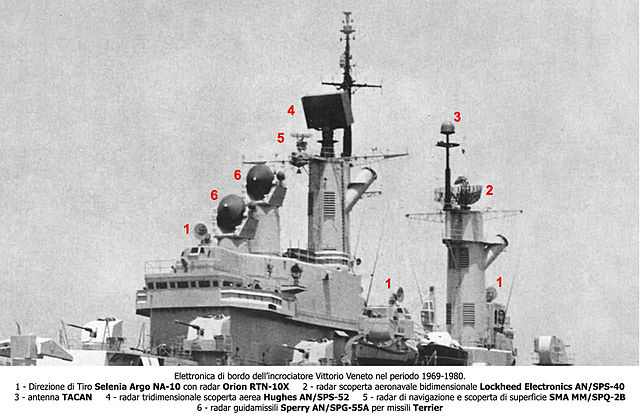

The electronics were rather advanced for the time, comprising a three-dimensional AN/SPS-52 B radar and an SPS-768 (RAN 3L) air search radar. For anti-submarine warfare an AN/SQS-23 sonar set was installed.
- 1 × SPS-52 early warning radar
- 1 × SPS-768 long range radar
- 1 × SPQ-2 surface radar
- 2 × SPG-55 missile fire control radar
- 4 × Orion 10X fire control radar
- 2 × Orion 20X fire control radar
- 1 × navigation radar
- 2 × SCLAR decoy launcher
- 1 × ECM system
- 1 × TACAN
Vittorio Veneto (1967) |
|
| Dimensions | 179.6 x 19.4 m x 6 m (589ft x 64ft x 19.7ft) |
| Displacement | 7,500 tons standard, 8,850 tons FL |
| Crew | 557 |
| Propulsion | 2 shafts geared steam turbines, 4 FW boilers 73,000 hp |
| Speed | 30.5 knots (56.5 km/h; 35.1 mph) Range 5,000 nm/16 kts |
| Armament | RIM-2 Terrier/ASROC, 4 OTOMAT SSM, 8×76mm, 3×2 40mm, 2×3 ASW 324mm TTs |
| Sensors | SPS-52, SPS-768, SPQ-2, SPG-55, Orion FCR, nav, ECM, SCLAR, Tacan |
| Aviation | 6-9 ASW helicopters, see notes |
Early career of Vittorio Veneto 1969-80
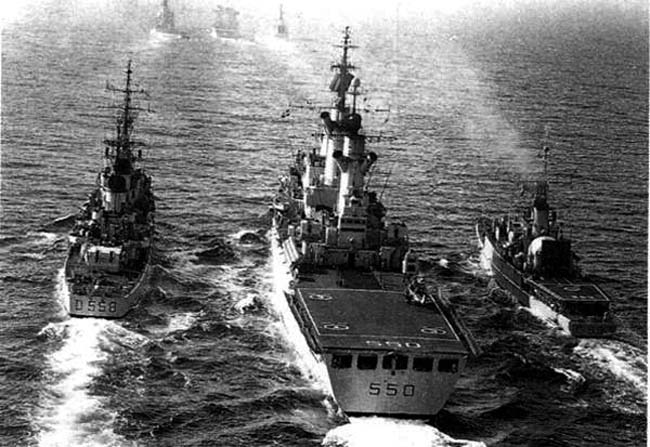
Early career, in Operation with the destroyer Impetuoso and frigate Margottini, 1970s
Sometimes called the third Andrea Doria class ships (the first design was the same with just a large hangar aft) the design was so strongly modified as to constitute a new class of its own. The Cruiser “Vittorio Veneto” was built at the Shipbuilding Yards of Castellammare di Stabia, the concrete result of years of redesign, seraching for the best compromise solution between demands of air defence and anti-submarine operations. It was to be assigned to multiple tasks, which include antiaircraft protection, antisubmarine and antiship protection of naval forces and convoys; antisubmarine warfare; and antiaircraft defense of a zone. The second prospective unit, to be named “Italia” was cancelled in favor of the “Garibaldi” aicraft carrier programme.
Completed at Navalmeccanica, still in Castellammare di Stabia, the cruiser, launched on 5 February 1967 was officially commissioned on 12 July 1969, with captain Vittorio Marulli in command, directing since 1966 the outfitting. Her became admiral in September 1981-January 1984 as well as Commander in Chief of the Naval Squadron. From February 1984 to 15 October 1985 he became also Chief of Navy General Staff. A veteran of WW2 he served already in the battleship Vittorio Veneto.
Veneto reached her operational base in Taranto for he first yearly deployment starting on 30 October. On 4 November, she was certified, receiving the Combat Flag in Trieste donated by the city of Vittorio Veneto. This combat flag was handed over by Countess Maria Francesca Frascara, widow of Admiral Corso Pecori Giraldi (former captain of the battleships Vittorio Veneto and 1955-1962 Chief of Staff).
After a year of service, she left for a long training cruise from April 25 to August 23, 1970 in the North Atlantic, visiting American and European ports along the way. Back to her operating base she trained with the missile cruiser Garibaldi. In 1971 Vittorio Veneto assumed the role of flagship for several years, only ceded to the aircraft carrier Giuseppe Garibaldi in 1987.
During her activity, the cruiser Vittorio Veneto participated in numerous national and international exercises within great NATO coalition manoeuvers always as command ship of escort groups to aircraft carrier units or large convoys. In 1972, (August 16, to October 29) she sailed with two frigates of the Bergamini class in a long training campaign in South America.
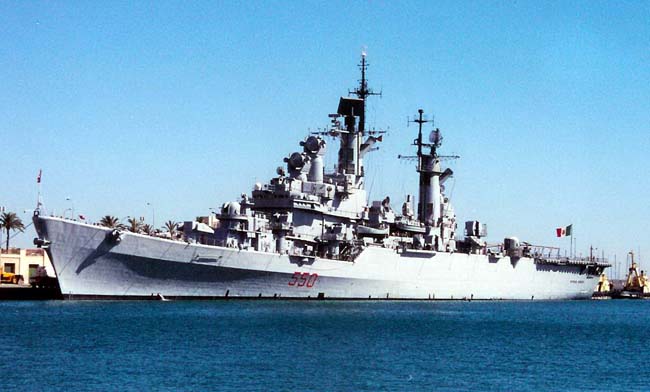
Veneto moored as TS in Malaga last years of service
The winter and spring of 1973 saw her teaming with Andrea Doria and the 3rd Helicopter Group in a relief effort towards the Tunisian populations affected by a major flood. She took part in a rescue operation of nationals hit by earthquakes at Friuli in 1976, and Irpinia in 1980. She made a world-cruise in 1977 which took a strain on the ship in general.
In 1978, Vittorio Veneto participated in the summer training cruise, with Livorno Academy’s second year students, replacing San Giorgio still under completion. Her navigation in the Indian Ocean saw hir hit hard by the monsoon. Her hangar was managed as a dormitory for the students during this cruiser and she only had a token provision of helioipters. In the summer of 1979, with Andrea Doria and the refueling vessel Stromboli (VIII Naval Group) she operated in the waters of the Gulf of Thailand , South China Sea, coming to rescue boats people. She carried back to Italy a thousand Vietnamese refugees fleeing their country back to Venice.
1980s refits

Veneto in 1985
The ship underwent an extensive update for three years at Castellamare di Stabia. Electronics were of course updated, Otomat Mk.2 missiles launchers for antiship warfare installed and a SPS-40 radar to go with these. Three OTO Melara twin 40 mm/70 Bread Compact (1.6 in) DARDO CIWS compact guns were also added for mixed AA/AM warfare. Her powerplant was modernized, using a new feeding system, without heavy oil but now diesel fuel.
Her improvements were suited to her multiple roles as anti-aircraft, anti-submarine protection and anti-ship, plus convoy escort and anti-submarine warfare, command and area air defence tasks. In hand from 1981 to early 1984 for modernisation which included the installation of four Teseo launchers and the three twin Breda compact 40 mm. Terrier missiles were removed, replaced by 40 Standard SM1 and 20 ASROC ASM – SM-1ER SAM/ASROC (40 RIM-67A, 20 RUR-5)- SAM/ASW twin missile launcher. Two SPG-55C Standard fire control systems were added, and Italian-built RAN-3L (SPS-768) and two RTN-20X (SPG-74) radars were installed to manage the new systems.
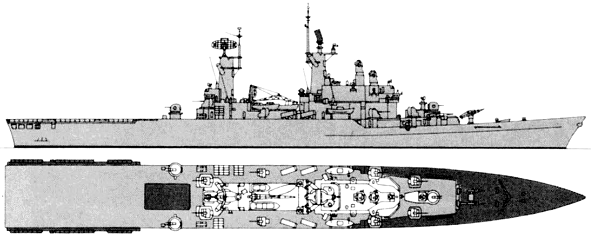
Profile of the Veneto in 1985. Src navypedia
Operations in Lebanon and Achille Lauro assault
In February 1984, she covered Italian troops operating under supervision of a UN operation to the second phase of “Lebano Due”, escorting convoys to and from Italy and with her helicopter, covering and transporting national contingents deployed in Beirut. In February 1985 she carried the italian president of the Republic Pertini during an official visit to Egypt. In October she took part in Operation Margherita, shadowing the transatlantic Achille Lauro seized by Palestinian terrorists. The whole operation was coordinated by Vittorio Veneto, using for the first time COMSUBIN paratroopers.
The 1990s: No longer a flagship
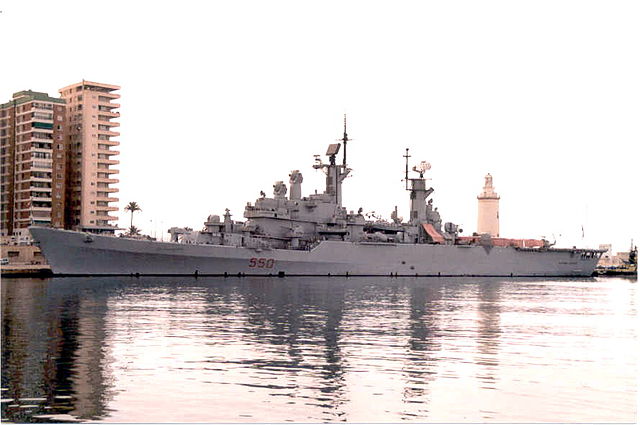
Veneto in Malaga, Spain, 2001
As the new aircraft carrier Giuseppe Garibaldi entere service on 30 September 1985, Vittorio Veneto lost her flagship role, but still went on participating in the most important national and international exercises of the Mediterranean, like Operation Ibis (1992-1993) in which she was the command ship of the 24th Naval Group with the Frigate Grecale, the fleet refueller Vesuvio, landing ships San Giorgio and San Marco carrying the “San Marco” Battalion in a large landing exercize.
In April-September 1993, Vittorio Veneto became the HQ Ship for STANAVFORMED, NATO permanent naval force in the Mediterranean. She took part in Operation Maritime Guard in the Adriatic.
Vittorio Veneto ran aground in bad weather off Vlorë on 22 April 1997, as flagship of a multinational task-force protectin a humanitarian relief operation to Albania. Four tugboats pulled free but she suffered no serious damage nor injuries.
After 1985 the guided-missile helicopter-carrying cruiser Vittorio Veneto was mainly -if not exclusively- operated as a training ship for 2-3 month yearly during her deployments to different parts of the world. At the time of her decommission in November 2003, she was not the last European cruiser in service, as the French cruiser Jeanne d’Arc (2010) remained longer. Her ASW air support role was assumed by the new generation V/STOL aircraft carrier Conte di Cavour. After lingering for some time in a mothball she was eventually stricken formally on 29 June 2006, but not sold yet. She was eventually purchased to be scrapped at Aliaga, Turkey, in 2021, so very recently indeed.
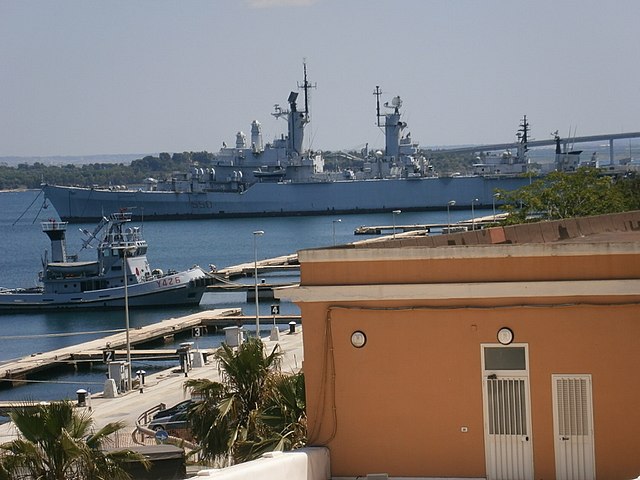
Veneto in Taranto
About the name:
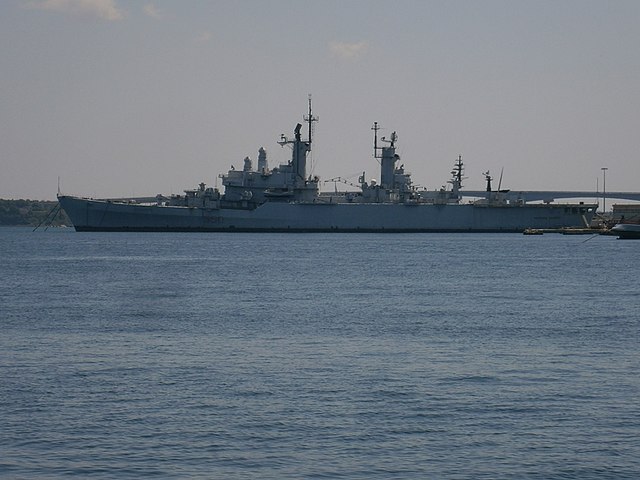
Veneto in taranto after decommission.
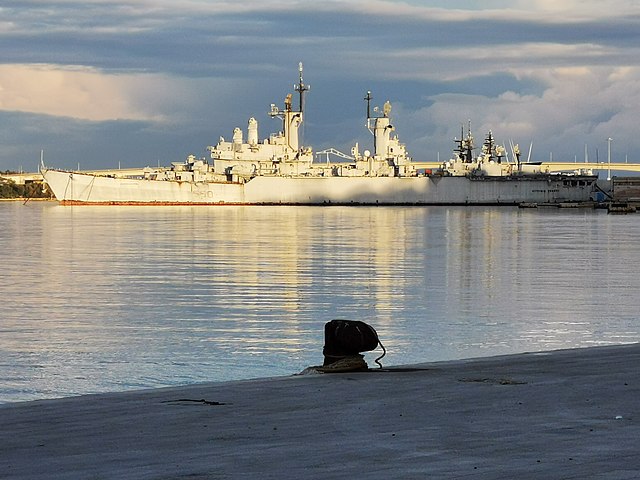
Veneto at sunset in taranto’s mothball, waiting to be sold for scrap, 2010s
The battle of Vittorio-Veneto was the largest Italian-Austro-Hungarian fight of the Great War, the Verdun on Italy. Engaging nearly two million combatants on a front of about 250 km in snow, from marshes in the south to icy fields in the plains and among lofty peaks and sometimes above the clouds in the Alps, it was planned and prepared in secret and executed on schedule like a vast tactical exercise, resulting on a crushing victory that erased the bad souvenir of Capporetto.
Read More/Src

Books:
J. Gardiner, Conway’s all the world’s fighting ships 1947-95
John Moore, ed. (1981). Jane’s Fighting Ships, 1981-1982. New York: Jane’s Information Group.
Gardiner & Chumbly, p.205
Sites:
On hazegray
On helis.com
On marina.difesa.it
On global security.org
On navypedia
On alcheton.com
On seaforces.org
On navalanalyses.com
On shipspotting.com/
On memim
cmano-db.com
losbarcosdeeugenio.com
Video: The last cruiser built in Western Europe
Model kit by Delphis Models | N° DM 034 | 1:700
3D model on 3dwarehouse



 Latest Facebook Entry -
Latest Facebook Entry -  X(Tweeter) Naval Encyclopedia's deck archive
X(Tweeter) Naval Encyclopedia's deck archive Instagram (@navalencyc)
Instagram (@navalencyc)





 French Navy
French Navy Royal Navy
Royal Navy Russian Navy
Russian Navy Armada Espanola
Armada Espanola Austrian Navy
Austrian Navy K.u.K. Kriegsmarine
K.u.K. Kriegsmarine Dansk Marine
Dansk Marine Nautiko Hellenon
Nautiko Hellenon Koninklije Marine 1870
Koninklije Marine 1870 Marinha do Brasil
Marinha do Brasil Osmanlı Donanması
Osmanlı Donanması Marina Do Peru
Marina Do Peru Marinha do Portugal
Marinha do Portugal Regia Marina 1870
Regia Marina 1870 Nihhon Kaigun 1870
Nihhon Kaigun 1870 Preußische Marine 1870
Preußische Marine 1870 Russkiy Flot 1870
Russkiy Flot 1870 Svenska marinen
Svenska marinen Søværnet
Søværnet Union Navy
Union Navy Confederate Navy
Confederate Navy Armada de Argentina
Armada de Argentina Imperial Chinese Navy
Imperial Chinese Navy Marinha do Portugal
Marinha do Portugal Mexico
Mexico Kaiserliche Marine
Kaiserliche Marine 1898 US Navy
1898 US Navy Sovietskiy Flot
Sovietskiy Flot Royal Canadian Navy
Royal Canadian Navy Royal Australian Navy
Royal Australian Navy RNZN Fleet
RNZN Fleet Chinese Navy 1937
Chinese Navy 1937 Kriegsmarine
Kriegsmarine Chilean Navy
Chilean Navy Danish Navy
Danish Navy Finnish Navy
Finnish Navy Hellenic Navy
Hellenic Navy Polish Navy
Polish Navy Romanian Navy
Romanian Navy Turkish Navy
Turkish Navy Royal Yugoslav Navy
Royal Yugoslav Navy Royal Thai Navy
Royal Thai Navy Minor Navies
Minor Navies Albania
Albania Austria
Austria Belgium
Belgium Columbia
Columbia Costa Rica
Costa Rica Cuba
Cuba Czechoslovakia
Czechoslovakia Dominican Republic
Dominican Republic Haiti
Haiti Hungary
Hungary Honduras
Honduras Estonia
Estonia Iceland
Iceland Eire
Eire Equador
Equador Iran
Iran Iraq
Iraq Latvia
Latvia Liberia
Liberia Lithuania
Lithuania Mandchukuo
Mandchukuo Morocco
Morocco Nicaragua
Nicaragua Persia
Persia San Salvador
San Salvador Sarawak
Sarawak Uruguay
Uruguay Venezuela
Venezuela Zanzibar
Zanzibar Warsaw Pact Navies
Warsaw Pact Navies Bulgaria
Bulgaria Hungary
Hungary

 Bundesmarine
Bundesmarine Dutch Navy
Dutch Navy Hellenic Navy
Hellenic Navy Marina Militare
Marina Militare Yugoslav Navy
Yugoslav Navy Chinese Navy
Chinese Navy Indian Navy
Indian Navy Indonesian Navy
Indonesian Navy JMSDF
JMSDF North Korean Navy
North Korean Navy Pakistani Navy
Pakistani Navy Philippines Navy
Philippines Navy ROKN
ROKN Rep. of Singapore Navy
Rep. of Singapore Navy Taiwanese Navy
Taiwanese Navy IDF Navy
IDF Navy Saudi Navy
Saudi Navy Royal New Zealand Navy
Royal New Zealand Navy Egyptian Navy
Egyptian Navy South African Navy
South African Navy






























 Ukrainian Navy
Ukrainian Navy dbodesign
dbodesign